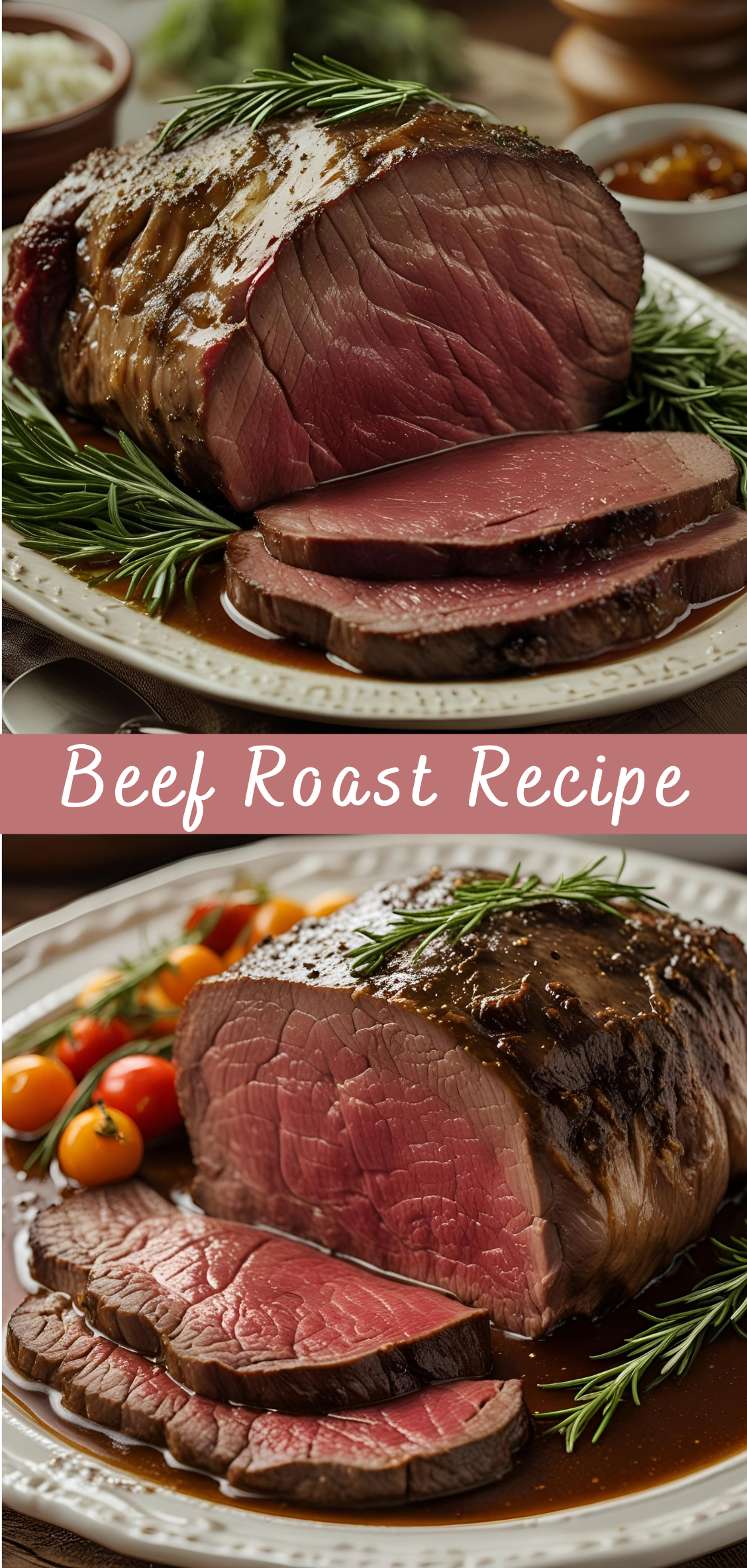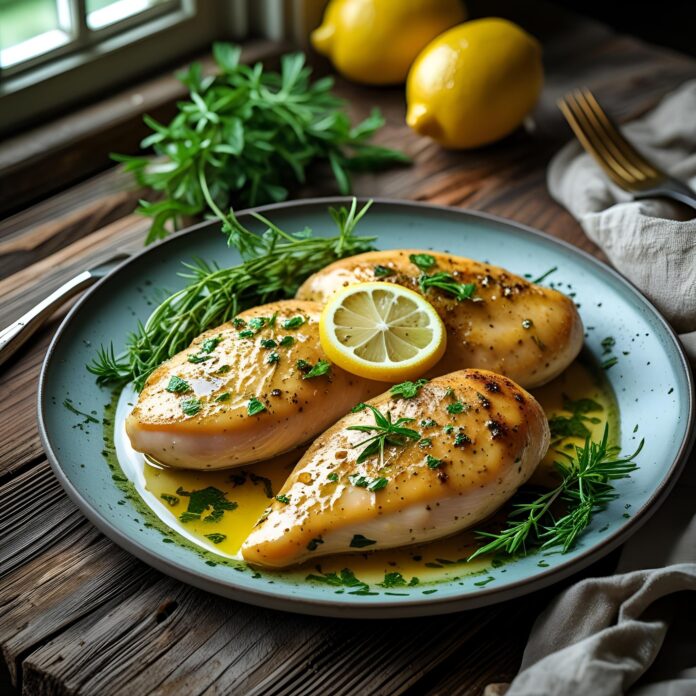Beef Roast Recipe
Few dishes evoke the same sense of tradition, warmth, and reverence as a properly prepared beef roast. It is a cornerstone of celebratory meals, Sunday dinners, and holiday gatherings around the world—a dish that doesn’t just fill a plate, but fills a home with anticipation. From the hearty, slow-cooked pot roasts of American farmhouses to the carefully seasoned joints of beef carved at British carving stations, the roast has long stood as a culinary symbol of comfort, prosperity, and ritual.

Unlike trendy recipes that come and go with changing diets and culinary fads, the beef roast has endured. It is rooted in history, steeped in regional traditions, and passed from one generation of cooks to the next—not merely as a recipe, but as a rite of passage. Nearly every culture with access to beef has its version of a roast, often reserved for the most meaningful occasions. Why? Because the roast is a dish that demands respect: from the cut of meat you choose to the patience required during its slow transformation from raw flesh into tender, savory perfection.
At its core, a beef roast is deceptively simple: a large cut of beef, seasoned and cooked until it is tender, juicy, and deeply flavorful. But behind that simplicity lies a complex interplay of temperature, time, technique, and texture. What cut of beef should you use—chuck, brisket, ribeye, tenderloin, or sirloin? Should it be braised slowly with aromatics, roasted dry in an oven, or cooked sous vide for precision? Do you want a crusty sear or a gentle, even roast? These are the kinds of decisions that transform an average roast into a memorable centerpiece.
That’s why this guide doesn’t aim to just give you a single recipe—it aims to explore the full art of making beef roast. We’ll begin by breaking down the different types of roasts and what makes each one unique. You’ll learn how to select the best cut based on flavor, fat content, and cooking method. From there, we’ll delve into the tools and preparation techniques that make a difference: seasoning strategies, tying and trussing, marinating, searing, and resting. Then we’ll walk step-by-step through one classic method—a herb-crusted oven roast—but we’ll also explore popular variations like slow cooker pot roast, red wine-braised roast, and reverse-seared roast beef for more advanced cooks.
Just as important as the cooking itself is the eating—and presentation. A roast isn’t just about feeding people; it’s about gathering them. That’s why we’ll cover everything from carving techniques to serving suggestions, sauce pairings, and ideal side dishes. Whether you’re planning a Sunday dinner for family or an elegant holiday feast for friends, we’ll help you understand how to time your roast, what to serve with it, and how to make it truly unforgettable.
A perfectly roasted beef is a culinary achievement that every cook should have in their repertoire. It teaches patience, attention to detail, and respect for ingredients. It’s about more than just temperature and timing—it’s about intuition, confidence, and care. When you bring a roast to the table, glistening and aromatic, you’re not just serving a meal—you’re carrying on a tradition. You’re offering warmth, generosity, and pride.
So whether this is your first attempt at roasting beef or you’re here to deepen your understanding and sharpen your technique, this comprehensive guide is designed to walk you through every step. With the right knowledge and a little practice, you’ll discover that mastering a beef roast isn’t just possible—it’s incredibly rewarding.
This is the story of the roast. Let’s begin.
Instructions: Step-by-Step for the Perfect Beef Roast
Step 1: Choosing the Right Cut of Beef
Estimated Time: 5–10 minutes (at the butcher or store)
The cut of beef you select will determine your roast’s texture, flavor, cook time, and even slicing method. Different cuts work better for different techniques.
Recommended Cuts for Oven Roasting:
-
Ribeye Roast (Prime Rib): Rich, marbled, luxurious — best for special occasions.
-
Top Sirloin Roast: Leaner than ribeye but still flavorful; great for everyday meals.
-
Tenderloin (Filet Mignon Roast): Incredibly tender, mild flavor — cooks quickly.
-
Strip Loin Roast (New York Strip Roast): A good balance of tenderness and bold flavor.
-
Eye of Round or Bottom Round: Lean, affordable — must be cooked carefully to avoid dryness.
Choosing Quality:
-
Look for good marbling (white streaks of fat within the meat). This ensures juiciness and flavor.
-
Ask your butcher for a well-trimmed roast with a fat cap of ¼ inch — it bastes the meat as it roasts.
-
For a bone-in roast (like prime rib), expect to serve 1 bone per 2 guests. A 3-rib roast serves about 6 people.
Once you’ve selected your cut, bring it home and let’s get started.
Step 2: Bring the Roast to Room Temperature
Estimated Time: 1 hour (passive time)
Roasting cold meat straight from the refrigerator causes uneven cooking. The exterior overcooks while the center remains raw.
What to Do:
-
Take your roast out of the fridge at least 1 hour before cooking.
-
Place it on a tray and loosely cover it with plastic wrap or a clean kitchen towel.
-
Let it sit at room temperature (ideally 65–70°F / 18–21°C).
This allows for even roasting and a smoother rise in internal temperature.
Note: Do not skip this step, especially for large roasts.
Step 3: Pat Dry and Season Generously
Estimated Time: 10 minutes
Moisture on the surface of the beef prevents browning. A dry surface helps build a beautiful crust.
Instructions:
-
Pat the roast dry thoroughly with paper towels.
-
Rub the entire surface with olive oil or softened butter — helps seasonings stick and aids browning.
-
Season liberally with:
-
Kosher salt: at least 1–1½ teaspoons per pound
-
Freshly cracked black pepper
-
Optional: smoked paprika, garlic powder, onion powder
-
For an Herb Crust:
Mix together:
-
2 tablespoons minced fresh rosemary
-
2 tablespoons minced fresh thyme
-
4 cloves garlic, crushed into a paste
-
1 tablespoon Dijon mustard (binds the herbs and adds tang)
-
2 tablespoons olive oil or butter
Rub this herb mixture all over the roast. Press it in firmly so it adheres.
Why it Matters: Salt draws out moisture, enhancing flavor. The herbs and mustard form a crust that adds complexity and protects the roast during cooking.
Step 4: Tie the Roast (Trussing)
Estimated Time: 5–7 minutes
Tying the roast helps it maintain an even shape, ensuring uniform cooking and more attractive slices.
How to Tie a Roast:
-
Use butcher’s twine.
-
Tie loops every 1 to 1½ inches along the roast’s length.
-
If using a tenderloin or sirloin with a tapered end, tuck the thin part under and tie it into a uniform cylinder.
Don’t Skip: A misshapen roast cooks unevenly. Trussing ensures professional results.
Step 5: Preheat Oven and Choose Your Roasting Setup
Estimated Time: 10 minutes
The oven and pan setup affects heat distribution and roast texture.
Oven Settings:
-
Preheat oven to 450°F (232°C).
-
Set a rack in the center.
-
Use convection if available for even browning.
Equipment:
-
Roasting pan with a rack (preferred)
-
Or a cast iron skillet or heavy-duty sheet pan with wire rack
-
Meat thermometer: Instant-read or probe-style digital thermometer is ideal
Place the roast on the rack fat-side up. This allows the fat to render and naturally baste the meat.
Step 6: Sear (Optional) or High-Heat Start
You can choose one of two paths here:
Option A: Sear First
-
Heat a cast iron skillet over high heat.
-
Add a tablespoon of high-heat oil (e.g., avocado or grapeseed).
-
Sear all sides of the roast (including ends) until browned, about 2–3 minutes per side.
-
Transfer to roasting pan.
Why Sear? It creates a flavorful crust through the Maillard reaction.
Option B: High-Heat Oven Start
-
Place the seasoned roast in the oven at 450°F for 15 minutes.
-
Then reduce oven to 325°F (163°C) for the remainder of cooking time.
Why This Works: The initial high heat mimics a sear, crisping the exterior and jump-starting browning.
Step 7: Roast to Your Desired Doneness
Estimated Time: 45 minutes to 2+ hours (depending on cut and size)
The only way to perfectly cook roast beef is by temperature, not time. Use a meat thermometer to monitor internal temperature closely.
Target Internal Temperatures:
-
Rare: 120–125°F (49–52°C)
-
Medium-Rare: 130–135°F (54–57°C)
-
Medium: 140–145°F (60–63°C)
-
Medium-Well: 150–155°F (65–68°C)
Remove the roast from the oven 5–10°F before your desired doneness — it will continue cooking as it rests.
Beef Roast Recipe
Few dishes evoke the same sense of tradition, warmth, and reverence as a properly prepared beef roast. It is a cornerstone of celebratory meals, Sunday dinners, and holiday gatherings around the world—a dish that doesn’t just fill a plate, but fills a home with anticipation. From the hearty, slow-cooked pot roasts of American farmhouses to the carefully seasoned joints of beef carved at British carving stations, the roast has long stood as a culinary symbol of comfort, prosperity, and ritual.
Ingredients
- 3 to 4 lb (1.5–2 kg) beef chuck roast (or top round, rump roast)
- Salt and freshly ground black pepper, to taste
- 2 tablespoons olive oil
- 1 onion, chopped
- 4 garlic cloves, minced
- 3–4 carrots, peeled and cut into chunks
- 3–4 potatoes, peeled and cut into chunks
- 2 cups beef broth (low sodium preferred)
- 1 cup red wine (optional, or substitute with more broth)
- 2 tablespoons tomato paste (optional, for richness)
- 2 sprigs fresh rosemary (or 1 tsp dried)
- 2 sprigs fresh thyme (or 1 tsp dried)
- 1 bay leaf
Instructions
- Preheat oven to 325°F (160°C).
- Season the roast generously with salt and pepper on all sides.
- Sear the meat:
Heat olive oil in a large Dutch oven or oven-safe pot over medium-high heat.
Sear the roast on all sides until nicely browned (about 3–4 minutes per side). Remove and set aside. - Sauté aromatics:
In the same pot, add onions and cook for 2–3 minutes until softened. Add garlic and tomato paste (if using) and stir for 1 minute. - Deglaze:
Pour in wine (or broth) and scrape up any browned bits from the bottom. Let simmer for 2 minutes. - Add everything back:
Return the roast to the pot. Add beef broth, carrots, potatoes, rosemary, thyme, and bay leaf. The liquid should come halfway up the sides of the roast — add more broth or water if needed. - Roast:
Cover the pot with a lid and place in the oven. Cook for 2.5 to 3 hours, or until the meat is fork-tender. - Rest & serve:
Remove from oven. Let roast rest for 10–15 minutes before slicing. Discard bay leaf and herb stems.
Notes
- Gravy option: After roasting, strain the cooking liquid and simmer it to reduce. Whisk in a cornstarch slurry (1 tbsp cornstarch + 2 tbsp water) to thicken into a gravy.
- Slow cooker method: Sear meat and aromatics first, then transfer to a slow cooker. Cook on LOW for 8 hours or HIGH for 4–5 hours.
- Veggie variations: Add celery, parsnips, or mushrooms for extra flavor.



